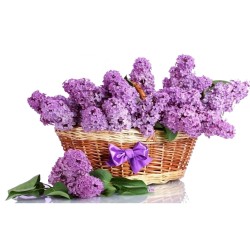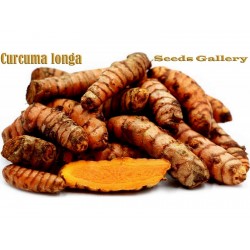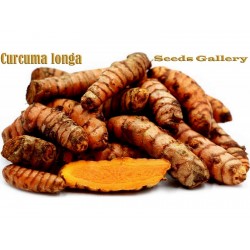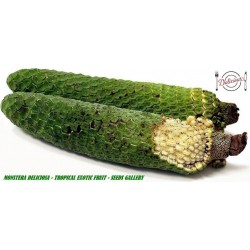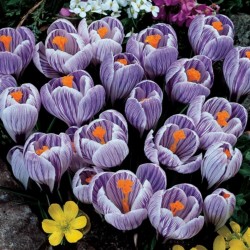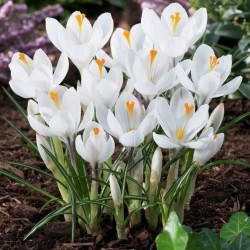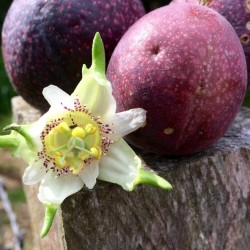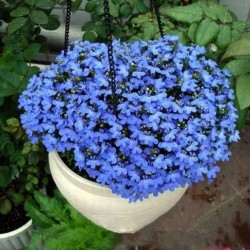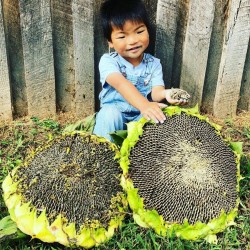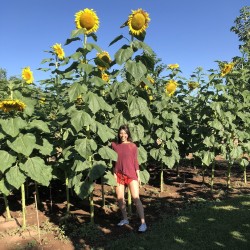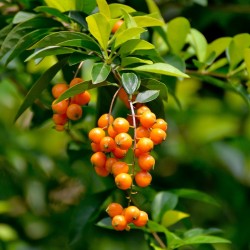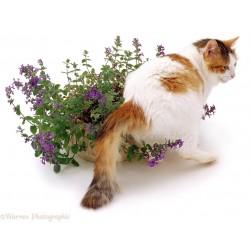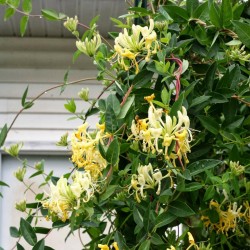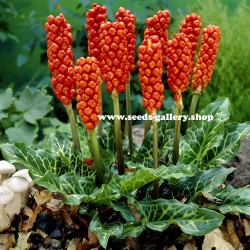Seeds Gallery EU,
5/
5
<h2><span style="font-size: 14pt;" class=""><b>Turmeric Live Rhizomes - spice (Curcuma longa)</b></span></h2>
<h3><span style="color: #f20202; font-size: 14pt;"><b>Price for package of <strong>5 </strong>Rhizomes.</b></span></h3>
<p><b>Turmeric</b> (<i>Curcuma longa</i>) (<span class="nowrap"><span class="IPA nopopups noexcerpt">/<span><span title="/ˈ/: primary stress follows">ˈ</span><span title="'t' in 'tie'">t</span><span title="/ɜːr/: 'ur' in 'fur'">ɜːr</span><span title="'m' in 'my'">m</span><span title="/ər/: 'er' in 'letter'">ər</span><span title="/ɪ/: 'i' in 'kit'">ɪ</span><span title="'k' in 'kind'">k</span></span>/</span></span>) is a rhizomatous herbaceous perennial plant of the ginger family, Zingiberaceae.<sup id="cite_ref-3" class="reference">[3]</sup> It is native to the Indian subcontinent and Southeast Asia, and requires temperatures between 20 and 30 °C (68–86 °F) and a considerable amount of annual rainfall to thrive. Plants are gathered annually for their rhizomes and propagated from some of those rhizomes in the following season.</p>
<p>When not used fresh, the rhizomes are boiled in water for about 30–45 minutes and then dried in hot ovens, after which they are ground into a deep-orange-yellow powder<sup id="cite_ref-4" class="reference">[4]</sup>commonly used as a coloring and flavoring agent in many Asian cuisines, especially for curries, as well as for dyeing. Turmeric powder has a warm, bitter, pepper-like flavor and earthy, mustard-like aroma.<sup id="cite_ref-drugs_5-0" class="reference">[5]</sup><sup id="cite_ref-brennan_6-0" class="reference">[6]</sup></p>
<p>Although long used in Ayurvedic medicine to treat various diseases, there is little high-quality clinical evidence for use of turmeric or its main constituent, curcumin, as a therapy.<sup id="cite_ref-nelson_7-0" class="reference">[7]</sup><sup id="cite_ref-nccih_8-0" class="reference">[8]</sup></p>
<div class="thumb tright">
<div class="thumbinner"><img alt="" src="https://upload.wikimedia.org/wikipedia/commons/thumb/2/2e/Curcuma_longa_-_K%C3%B6hler%E2%80%93s_Medizinal-Pflanzen-199.jpg/200px-Curcuma_longa_-_K%C3%B6hler%E2%80%93s_Medizinal-Pflanzen-199.jpg" class="thumbimage" width="200" height="245">
<div class="thumbcaption">
<div class="magnify"></div>
Botanical view of <i>Curcuma longa</i></div>
</div>
</div>
<h2><span class="mw-headline" id="History">History</span></h2>
<p>Turmeric has been used in Asia for thousands of years and is a major part of Ayurveda, Siddha medicine, Unani, and traditional Chinese medicine.<sup id="cite_ref-Chattopadhyay_9-0" class="reference">[9]</sup> It was first used as a dye, and then later for its medicinal properties.<sup id="cite_ref-NCCIH_10-0" class="reference">[10]</sup></p>
<h2><span class="mw-headline" id="Etymology">Etymology</span></h2>
<p>The origin of the name is uncertain. It possibly derives from Middle English or Early Modern English as <i><span xml:lang="enm" lang="enm">turmeryte</span></i> or <i><span xml:lang="enm" lang="enm">tarmaret</span></i>. It may be of Latin origin, <i><span xml:lang="la" lang="la">terra merita</span></i> ("meritorious earth").<sup id="cite_ref-11" class="reference">[11]</sup> The name of the genus, <i>Curcuma</i>, is derived from the Sanskrit <i><span xml:lang="sa-latn" lang="sa-latn">kuṅkuma</span></i>, referring to both turmeric and saffron, used in India since ancient times.<sup id="cite_ref-12" class="reference">[12]</sup></p>
<h2><span class="mw-headline" id="Botanical_description">Botanical description</span></h2>
<h3><span class="mw-headline" id="Appearance">Appearance</span></h3>
<p>Turmeric is a perennial herbaceous plant that reaches up to 1 m (3 ft 3 in) tall. Highly branched, yellow to orange, cylindrical, aromatic rhizomes are found. The leaves are alternateand arranged in two rows. They are divided into leaf sheath, petiole, and leaf blade.<sup id="cite_ref-13" class="reference">[13]</sup> From the leaf sheaths, a false stem is formed. The petiole is 50 to 115 cm (20–45 in) long. The simple leaf blades are usually 76 to 115 cm (30–45 in) long and rarely up to 230 cm (91 in). They have a width of 38 to 45 cm (15–18 in) and are oblong to elliptic, narrowing at the tip.</p>
<h3><span id="Inflorescence.2C_flower.2C_and_fruit"></span><span class="mw-headline">Inflorescence, flower, and fruit</span></h3>
<div class="thumb tright">
<div class="thumbinner"><img alt="" src="https://upload.wikimedia.org/wikipedia/commons/thumb/4/41/Turmeric_Flower_Maharashtra_India.jpg/220px-Turmeric_Flower_Maharashtra_India.jpg" class="thumbimage" width="220" height="157">
<div class="thumbcaption">
<div class="magnify"></div>
Turmeric flower</div>
</div>
</div>
<div class="thumb tright">
<div class="thumbinner"><img alt="" src="https://upload.wikimedia.org/wikipedia/commons/thumb/8/8b/Native_Turmeric_Cooktown.jpg/220px-Native_Turmeric_Cooktown.jpg" class="thumbimage" width="220" height="293">
<div class="thumbcaption">
<div class="magnify"></div>
Wild turmeric, Australia</div>
</div>
</div>
<p>At the top of the inflorescence, stem bracts are present on which no flowers occur; these are white to green and sometimes, tinged reddish-purple, and the upper ends are tapered.<sup id="cite_ref-14" class="reference">[14]</sup></p>
<p>The hermaphrodite flowers are zygomorphic and threefold. The three 0.8 to 1.2 cm (0.3–0.5 in) long sepals are fused, white, have fluffy hairs and the three calyx teeth are unequal. The three bright-yellow petals are fused into a corolla tube up to 3 cm (1.2 in) long. The three corolla lobes have a length of 1.0 to 1.5 cm (0.39–0.59 in) and are triangular with soft-spiny upper ends. While the average corolla lobe is larger than the two lateral, only the median stamen of the inner circle is fertile. The dust bag is spurred at its base. All other stamens are converted to staminodes. The outer staminodes are shorter than the labellum. The labellum is yellowish, with a yellow ribbon in its center and it is obovate, with a length from 1.2 to 2.0 cm (0.47–0.79 in). Three carpels are under a constant, trilobed ovary adherent, which is sparsely hairy. The fruit capsule opens with three compartments.<sup id="cite_ref-Siewek_15-0" class="reference">[15]</sup><sup id="cite_ref-kaufen_16-0" class="reference">[16]</sup><sup id="cite_ref-HKRS_17-0" class="reference">[17]</sup></p>
<p>In East Asia, the flowering time is usually in August. Terminally on the false stem is a 12 to 20 cm (4.7–7.9 in) long inflorescence stem containing many flowers. The bracts are light green and ovate to oblong with a blunt upper end with a length of 3 to 5 cm (1.2–2.0 in).</p>
<h2><span class="mw-headline" id="Phytochemistry">Phytochemistry</span></h2>
<div class="thumb tright">
<div class="thumbinner"><img alt="" src="https://upload.wikimedia.org/wikipedia/commons/thumb/c/c9/CurcuminKeto.svg/256px-CurcuminKeto.svg.png" class="thumbimage" width="256" height="75">
<div class="thumbcaption">Curcumin keto form</div>
</div>
</div>
<div class="thumb tright">
<div class="thumbinner"><img alt="" src="https://upload.wikimedia.org/wikipedia/commons/thumb/4/40/Curcumin.svg/256px-Curcumin.svg.png" class="thumbimage" width="256" height="75">
<div class="thumbcaption">Curcumin enol form</div>
</div>
</div>
<p>Turmeric powder is approximately 60–70% carbohydrates, 6–13% water, 6–8% protein, 5–10% fat, 3–7% dietary minerals, 3–7% essential oils, 2–7% dietary fiber, and 1–6% curcuminoids.<sup id="cite_ref-nelson_7-1" class="reference">[7]</sup></p>
<p>Phytochemical components of turmeric include diarylheptanoids, which occur from numerous curcuminoids, such as curcumin, demethoxycurcumin, and bisdemethoxycurcumin.<sup id="cite_ref-nelson_7-2" class="reference">[7]</sup>Curcumin constitutes 3.14% (on average) of powdered turmeric, having variations in content among the species of <i>Curcuma longa</i>.<sup id="cite_ref-18" class="reference">[18]</sup> Some 34 essential oils are present in turmeric, among which turmerone, germacrone, atlantone, and zingiberene are major constituents.<sup id="cite_ref-19" class="reference">[19]</sup><sup id="cite_ref-20" class="reference">[20]</sup><sup id="cite_ref-21" class="reference">[21]</sup></p>
<h2><span class="mw-headline" id="Uses">Uses</span></h2>
<h3><span class="mw-headline" id="Traditional_medicine">Traditional medicine</span></h3>
<p>Turmeric grows wild in the forests of South and Southeast Asia where it is collected for use in Indian traditional medicine (also called Siddha or Ayurveda).<sup id="cite_ref-nelson_7-3" class="reference">[7]</sup> From clinical research, there is no high-quality evidence that turmeric has medicinal properties.<sup id="cite_ref-nelson_7-4" class="reference">[7]</sup></p>
<h3><span class="mw-headline" id="Culinary">Culinary</span></h3>
<div class="thumb tright">
<div class="thumbinner"><br><img alt="" src="https://upload.wikimedia.org/wikipedia/commons/thumb/5/5b/Curcuma_longa_roots.jpg/220px-Curcuma_longa_roots.jpg" class="thumbimage" width="220" height="91"><img alt="" src="https://upload.wikimedia.org/wikipedia/commons/thumb/0/0a/Turmeric-powder.jpg/220px-Turmeric-powder.jpg" class="thumbimage" width="220" height="220">
<div class="thumbcaption">
<div class="magnify"></div>
Turmeric powder</div>
</div>
</div>
<div class="thumb tright">
<div class="thumbinner">
<div class="thumbcaption">
<div class="magnify"></div>
Turmeric rhizome and powder</div>
</div>
</div>
<div class="thumb tright">
<div class="thumbinner"><img alt="" src="https://upload.wikimedia.org/wikipedia/commons/thumb/c/c0/%E0%A4%93%E0%A4%B2%E0%A5%8D%E0%A4%AF%E0%A4%BE_%E0%A4%B9%E0%A4%B3%E0%A4%A6%E0%A5%80%E0%A4%9A%E0%A5%80_%E0%A4%AD%E0%A4%BE%E0%A4%9C%E0%A5%80.jpg/220px-%E0%A4%93%E0%A4%B2%E0%A5%8D%E0%A4%AF%E0%A4%BE_%E0%A4%B9%E0%A4%B3%E0%A4%A6%E0%A5%80%E0%A4%9A%E0%A5%80_%E0%A4%AD%E0%A4%BE%E0%A4%9C%E0%A5%80.jpg" class="thumbimage" width="220" height="165">
<div class="thumbcaption">
<div class="magnify"></div>
Curry using turmeric, referred to as <i>haldi ki Sabji</i>, a dish from India</div>
</div>
</div>
<div class="thumb tright">
<div class="thumbinner"><img alt="" src="https://upload.wikimedia.org/wikipedia/commons/thumb/6/62/Ganghwang-bap.jpg/220px-Ganghwang-bap.jpg" class="thumbimage" width="220" height="147">
<div class="thumbcaption">
<div class="magnify"></div>
<i>Ganghwang-bap</i> (turmeric rice)</div>
</div>
</div>
<div class="thumb tright">
<div class="thumbinner"><img alt="" src="https://upload.wikimedia.org/wikipedia/commons/thumb/a/ae/Steamed_Goan_rice_and_jaggery_cakes.jpg/220px-Steamed_Goan_rice_and_jaggery_cakes.jpg" class="thumbimage" width="220" height="213">
<div class="thumbcaption">
<div class="magnify"></div>
<i>Patoleo</i> – sweet rice cakessteamed in turmeric leaves consisting of a filling of coconut and coconut palm sugar prepared in Goan Catholic style.</div>
</div>
</div>
<p>Turmeric is one of the key ingredients in many Asian dishes, imparting a mustard-like, earthy aroma and pungent, slightly bitter flavor to foods.<sup id="cite_ref-drugs_5-1" class="reference">[5]</sup><sup id="cite_ref-brennan_6-1" class="reference">[6]</sup> Turmeric is used mostly in savory dishes, but also is used in some sweet dishes, such as the cake <i>sfouf</i>. In India, turmeric plant leaf is used to prepare special sweet dishes, <i>Patoleo</i>, by layering rice flour and coconut-jaggery mixture on the leaf, then closing and steaming it in a special utensil (<i>chondrõ</i>).<sup id="cite_ref-tradition_22-0" class="reference">[22]</sup> Most turmeric is used in the form of rhizome powder to impart a golden yellow color.<sup id="cite_ref-drugs_5-2" class="reference">[5]</sup><sup id="cite_ref-brennan_6-2" class="reference">[6]</sup> It is used in many products such as canned beverages, baked products, dairy products, ice cream, yogurt, yellow cakes, orange juice, biscuits, popcorn color, cereals, sauces, and gelatin. It is a principal ingredient in curry powders.<sup id="cite_ref-drugs_5-3" class="reference">[5]</sup> Although typically used in its dried, powdered form, turmeric also is used fresh, like ginger. It has numerous uses in East Asian recipes, such as pickle that contains large chunks of soft turmeric, made from fresh turmeric.</p>
<p>Turmeric is used widely as a spice in South Asian and Middle Eastern cooking. Various Iranian <i>khoresh</i> dishes are started using onions caramelized in oil and turmeric, followed by other ingredients. The Moroccan spice mix ras el hanout typically includes turmeric. In South Africa, turmeric is used to give boiled white rice a golden color, known as <i>geelrys</i>(yellow rice) traditionally served with bobotie. In Vietnamese cuisine, turmeric powder is used to color and enhance the flavors of certain dishes, such as <i>bánh xèo, bánh khọt</i>, and <i>mi quang</i>. The staple Cambodian curry paste, <i>kroeung</i>, used in many dishes including <i>Amok</i>, typically contains fresh turmeric. In Indonesia, turmeric leaves are used for Minang or Padang curry base of Sumatra, such as <i>rendang</i>, <i>sate padang</i>, and many other varieties. In Thailand, fresh turmeric rhizomes are used widely in many dishes, in particular in the southern Thai cuisine, such as yellow curry and turmeric soup. Turmeric is used in a hot drink called the "turmeric latte" or "golden milk" made with non-dairy milks, such as coconut milk.<sup id="cite_ref-23" class="reference">[23]</sup></p>
<h3><span class="mw-headline" id="Dye">Dye</span></h3>
<p>Turmeric makes a poor fabric dye, as it is not very light fast, but is commonly used in Indian clothing, such as saris and Buddhist monks's robes.<sup id="cite_ref-brennan_6-3" class="reference">[6]</sup> Turmeric (coded as E100, when used as a food additive),<sup id="cite_ref-24" class="reference">[24]</sup> is used to protect food products from sunlight. The oleoresin is used for oil-containing products. A curcumin and polysorbate solution or curcumin powder dissolved in alcohol is used for water-containing products. Over-coloring, such as in pickles, relishes, and mustard, is sometimes used to compensate for fading.</p>
<p>In combination with annatto (E160b), turmeric has been used to color cheeses, yogurt, dry mixes, salad dressings, winter butter, and margarine. Turmeric also is used to give a yellow color to some prepared mustards, canned chicken broths, and other foods (often as a much cheaper replacement for saffron).<sup id="cite_ref-25" class="reference">[25]</sup></p>
<h3><span class="mw-headline" id="Indicator">Indicator</span></h3>
<p>Turmeric paper, also called curcuma paper or in German literature, <i>Curcumapapier</i>, is paper steeped in a tincture of turmeric and allowed to dry. It is used in chemical analysis as an indicator for acidity and alkalinity.<sup id="cite_ref-26" class="reference">[26]</sup> The paper is yellow in acidic and neutral solutions and turns brown to reddish-brown in alkaline solutions, with transition between pH of 7.4 and 9.2.<sup id="cite_ref-27" class="reference">[27]</sup></p>
<h3><span class="mw-headline" id="Traditional_uses">Traditional uses</span></h3>
<div class="thumb tright">
<div class="thumbinner"><img alt="" src="https://upload.wikimedia.org/wikipedia/commons/thumb/d/dc/Naturalis_Biodiversity_Center_-_L.0939330_-_Bernecker%2C_A._-_Curcuma_domestica_Valeton_-_Artwork.jpeg/220px-Naturalis_Biodiversity_Center_-_L.0939330_-_Bernecker%2C_A._-_Curcuma_domestica_Valeton_-_Artwork.jpeg" class="thumbimage" width="220" height="286">
<div class="thumbcaption">
<div class="magnify"></div>
<i>Curcuma domestica</i> Valeton, a drawing by A. Bernecker around 1860</div>
</div>
</div>
<p>In Ayurvedic and Siddha practices, turmeric has been used as an attempted treatment for a variety of internal disorders, such as indigestion, throat infections, common colds, or liver ailments, as well as topically, to cleanse wounds or treat skin sores.<sup id="cite_ref-nelson_7-5" class="reference">[7]</sup><sup id="cite_ref-nccih_8-1" class="reference">[8]</sup></p>
<p>In Eastern India, the plant is used as one of the nine components of navapatrika along with young plantain or banana plant, taro leaves, barley (<i>jayanti</i>), wood apple (<i>bilva</i>), pomegranate (<i>darimba</i>), <i>asoka</i>, <i>manaka</i> or <i>manakochu</i>, and rice paddy. The Navapatrika worship is an important part of Durga festival rituals.<sup id="cite_ref-28" class="reference">[28]</sup></p>
<p>Haldi ceremony (called <i>Gaye holud</i> in Bengal) (literally "yellow on the body") is a ceremony observed during Hindu and South Asian Muslim wedding celebrations in many parts of India, including Bengal, Punjab, Maharashtra, and Gujarat, and in Pakistan.<sup id="cite_ref-29" class="reference">[29]</sup></p>
<p>In Tamil Nadu and Andhra Pradesh, as a part of the Tamil–Telugu marriage ritual, dried turmeric tuber tied with string is used to create a Thali necklace, the equivalent of marriage rings in western cultures. In western and coastal India, during weddings of the Marathi and Konkani people, Kannada Brahmins turmeric tubers are tied with strings by the couple to their wrists during a ceremony, <i>Kankanabandhana</i>.<sup id="cite_ref-maha_30-0" class="reference">[30]</sup></p>
<div class="center">
<div class="thumb tnone">
<div class="thumbinner"><img alt="" src="https://upload.wikimedia.org/wikipedia/commons/thumb/c/c1/Khandoba_temple_Pune.jpg/550px-Khandoba_temple_Pune.jpg" class="thumbimage" width="550" height="376">
<div class="thumbcaption">
<div class="magnify"></div>
Khandoba's newer Temple in Jejuri. Notice devotees showering turmeric powder (bhandara) on each other.</div>
</div>
</div>
</div>
<p>Friedrich Ratzel reported in <i>The History of Mankind</i> during 1896, that in Micronesia, turmeric powder was applied for embellishment of body, clothing, utensils, and ceremonial uses.<sup id="cite_ref-31" class="reference">[31]</sup></p>
<h2><span class="mw-headline" id="Adulteration">Adulteration</span></h2>
<p>As turmeric and other spices are commonly sold by weight, the potential exists for powders of toxic, cheaper agents with a similar color to be added, such as lead(II,IV) oxide, giving turmeric an orange-red color instead of its native gold-yellow.<sup id="cite_ref-32" class="reference">[32]</sup> Another common adulterant in turmeric, metanil yellow (also known as acid yellow 36), is considered an illegal dye for use in foods by the British Food Standards Agency.<sup id="cite_ref-33" class="reference">[33]</sup></p>
<h2><span class="mw-headline" id="Medical_research">Medical research</span></h2>
<div class="hatnote navigation-not-searchable">See also: Curcumin</div>
<p>Claims that curcumin in turmeric may help to reduce inflammation have not been supported by strong studies.<sup id="cite_ref-nelson_7-6" class="reference">[7]</sup><sup id="cite_ref-nccih_8-2" class="reference">[8]</sup></p>
<p>Turmeric or its principal constituent, curcumin, has been studied in numerous clinical trials for various human diseases and conditions, but the conclusions have either been uncertain or negative.<sup id="cite_ref-nelson_7-7" class="reference">[7]</sup><sup id="cite_ref-34" class="reference">[34]</sup><sup id="cite_ref-35" class="reference">[35]</sup></p>
Z 1
